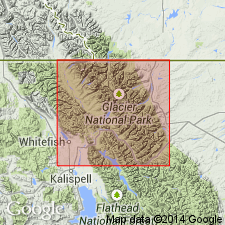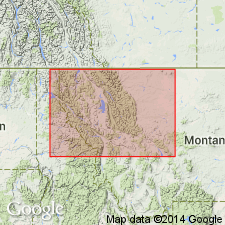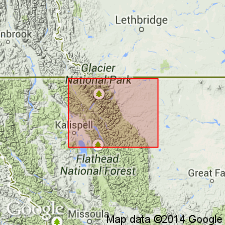
- Usage in publication:
-
- Appistoki member
- Modifications:
-
- Original reference
- Dominant lithology:
-
- Argillite
- Quartzite
- AAPG geologic province:
-
- Northern Rocky Mountain region
Summary:
Pg. 670-679. [Appistoki member of Appekunny argillite.] Middle member of Appekunny formation. Consists of 2,000 to 2,200 feet of thin-bedded to thick-bedded meta-argillite, with minor beds of siliceous argillite and quartzite. On Rising Wolf and Appistoki Mountains, in southern part of Lewis Rnage, Glacier National Park, northwestern Montana, this member consists of a lower series of brownish to black meta-argillites and upper greenish series which forms heavy ledges and falls. Northward to Blackiston Brook, southern Alberta, Canada, the member becomes more highly siliceous, with beds of quartzite; the color becomes green in lower portions. Underlies Rising Wolf member and overlies Singleshot member. Age is pre-Cambrian (Belt).
Source: US geologic names lexicon (USGS Bull. 896, p. 62).

- Usage in publication:
-
- Appistoki member
- Modifications:
-
- Principal reference
- AAPG geologic province:
-
- Northern Rocky Mountain region
Summary:
Pg. 1886. [Appistoki member of Appekunny formation of Ravalli group.] Gray, green, olive-brown, and rusty-gray argillites in thin minor, but thick major, beds interbedded with thickly stratified greenish, white, or pink quartzites. Member intergrades with other members, yet preserves fairly well-marked limits. Thickness in Lewis Range 2,000 to 2,200 feet. Underlies Scenic Point member (new); overlies Singleshot member. Type locality designated. [Age is Precambrian (Belt).]
Type locality: Appistoki Peak, near Two Medicine Lake, Glacier National Park, northwestern MT.
Source: US geologic names lexicon (USGS Bull. 1200, p. 118-119).

- Usage in publication:
-
- Appistoki member
- Modifications:
-
- [Abandoned]
- AAPG geologic province:
-
- Northern Rocky Mountain region
Summary:
Pg. 21-27. Appistoki member of Appekunny argillite. Rocks mapped in present investigation as belonging to Appekunny argillite may correspond essentially to Appistoki member of Fenton and Fenton (1937).
[According to CSPG Western Canada Lexicon, abandoned by Ross. Shown to be equivalent to Appekuny Formation of Willis (1902).]
Source: US geologic names lexicon (USGS Bull. 1200, p. 118-119).

- Usage in publication:
-
- Appistoki Member
- Modifications:
-
- [Abandoned]
- AAPG geologic province:
-
- Northern Rocky Mountain region
Summary:
Cannot be traced far enough to be valid as a formally named unit. Fenton and Fenton (1931, 1937) divisions of Appekunny not used in western Montana.
Source: GNU records (USGS DDS-6; Denver GNULEX).
For more information, please contact Nancy Stamm, Geologic Names Committee Secretary.
Asterisk (*) indicates published by U.S. Geological Survey authors.
"No current usage" (†) implies that a name has been abandoned or has fallen into disuse. Former usage and, if known, replacement name given in parentheses ( ).
Slash (/) indicates name conflicts with nomenclatural guidelines (CSN, 1933; ACSN, 1961, 1970; NACSN, 1983, 2005, 2021). May be explained within brackets ([ ]).

